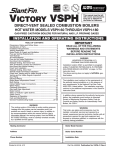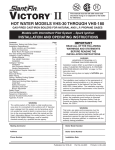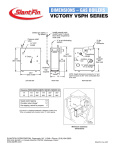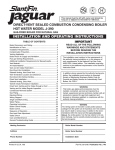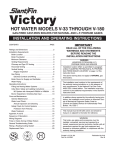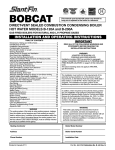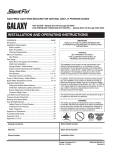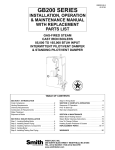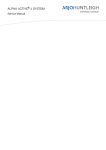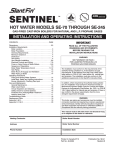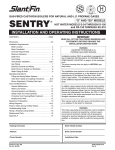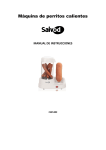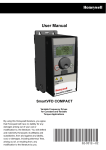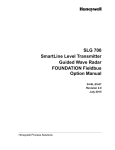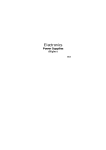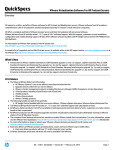Download Slant/Fin VSPH-180 User's Manual
Transcript
® ™ VICTORY VSPH This manual must be left with owner and should be hung on or adjacent to the boiler for reference. DIRECT-VENT SEALED COMBUSTION BOILERS HOT WATER MODELS VSPH-60 THROUGH VSPH-180 GAS-FIRED CAST-IRON BOILERS FOR NATURAL AND L.P. PROPANE GASES INSTALLATION AND OPERATING INSTRUCTIONS TABLE OF CONTENTS Dimensions, Rating and Orifice Sizes ........................................2 Identification of Parts ..................................................................3 Installation Requirements ...........................................................4 Venting Application .....................................................................5 Boiler Room Air Supply and Ventilation......................................5 Flue gas Venting Requirements..................................................5 Vent Material ..............................................................................5 Air Intake Material ......................................................................6 Flue and Air Intake Restrictions .................................................6 Non-Direct Vent Installation ........................................................8 Sidewall Venting, Non-Direct Vent ..............................................8 Vent Termination Location and Clearance..................................8 Non-Direct Vent Vertical Venting .................................................8 Direct Vent Installation ................................................................8 Sidewall Venting, Direct Vent ......................................................8 Vent/Air Intake Termination Installation.......................................8 Direct Vent, Venting and Air Intake through a Roof ..................13 Venting and Air Intake Regular Inspection ...............................15 Gas Piping ................................................................................15 Electrical Wiring ........................................................................15 Multi Zoning ..............................................................................18 Water Piping .............................................................................18 Wiring Diagram .........................................................................16 Operating Instructions...............................................................19 Gas Input Rate Adjustment ......................................................20 Boiler Control ............................................................................22 Sequence of Operation.............................................................21 Status of Indicator Lights (LED’s) .............................................22 Safety Check ...........................................................................23 Care and Maintenance .............................................................24 General Troubleshooting Guide ...........................................25-27 WARNING The venting system of this boiler is under positive pressure. Leakage from this system can be hazardous and if not avoided can result in death or serious injury. In addition to the recommendations within this manual and the User’s Information Manual, the venting system, from the blower to the outdoor discharge, must be carefully checked annually by a qualified service agency. IMPORTANT READ ALL OF THE FOLLOWING WARNINGS AND STATEMENTS BEFORE READING THE INSTALLATION INSTRUCTIONS WARNING LIQUEFIED PETROLEUM (L.P.) PROPANE GAS-FIRED BOILERS Installation location ONLY as permitted in paragraph entitled "LIQUEFIED PETROLEUM (L.P.) PROPANE GAS-FIRED BOILER LOCATION" on page 4 of this instruction book. The above warning does not apply to NATURAL gasfired boilers. The installation must conform to the requirements of the authority having jurisdiction or, in the absence of such requirements, to the National Fuel Gas Code, ANSI Z223.1-latest edition. The installation must also conform to the additional requirements in this Slant/Fin Instruction Book. In addition where required by the authority having jurisdiction, the installation must conform to American Society of Mechanical Engineers Safety Code for Controls and Safety Devices for Automatically Fired Boilers, No. CSD-1. WARNING This boiler, gas piping and accessories must be installed, connected, serviced and repaired by a trained, experienced service technician, familiar with all precautions required for gas-fired equipment and licensed or otherwise qualified, in compliance with the authority having jurisdiction. Heating Contractor Boiler Model Number Address Boiler Serial Number Phone Number Installation Date Printed in U.S.A. 207 Part No. 455035 Publication No. VSPH-40 Rev. A 2 VICTORY VSPH Models RATINGS AND DIMENSIONS NOTE: Height dimensions increase by 11⁄2" and depth increases to 281⁄2" when combustible floor kit is used. Figure 1. Dimensions data Boiler Model Input Btuh No. of Sections B VSPH-60 60,000 3 A 111⁄8" 173⁄8" VSPH-90 90,000 4 141⁄8" 203⁄8" VSPH-120 120,000 5 171⁄8" 233⁄8" VSPH-150 150,000 6 201⁄8" 263⁄8" VSPH-180 180,000 7 231⁄8" 293⁄8" Gas Orifice Size Victory VSPH boiler Orifice Sizes for High Altitudes Includes 4% Reduction for Each 1000 Feet Orifice Size for Sea Level 2000 3000 4000 8000 9000 10000 Natural #49 50 50 50 51 51 51 52 52 52 Propane #57 58 59 59 60 60 61 62 63 63 Gas Type Elevation — Feet 5000 6000 7000 Orifice sizes indicated for sea level above are factory installed in boiler unless otherwise specified by the local authority. Orifice table is based on a higher heating value between 1000 Btuh and 1010 Btuh for Natural Gas (See page 20, if local higher heating value exceeds these numbers). See page 20, for burner input adjustment. 3 VICTORY VSPH Models LOCATION AND IDENTIFICATION OF PARTS Base Assembly Figure 2. Location and identification of parts 4 INSTALLATION REQUIREMENTS The installation must conform to the requirements of the authority having jurisdiction or, in the absence of such requirements, to the National Fuel Gas Code, ANSI Z223.1latest edition. This installation must also conform to the additional requirements in this Slant/Fin Instruction Book. NATURAL GAS-FIRED BOILER LOCATION Provide a level, solid foundation for the boiler. Location should be as near as possible to chimney or outside wall so that the flue pipe from boiler is short and direct. (See Appendix A for vent terminal location restrictions.) The location should also be such that all boiler components are protected from water (dripping, spraying, rain, etc.) during appliance operation and service (circulator replacement, control replacement, etc.). WARNING LIQUEFIED PETROLEUM (L.P.) PROPANE GAS-FIRED BOILER LOCATION REQUIRES SPECIAL ATTENTION Liquefied Petroleum (L.P.) propane gas is heavier than air. Therefore, propane boilers, piping, valves should NOT be installed in locations where propane leaking from defective equipment and piping will "pool" in a basement or other space below the leak. VICTORY VSPH Models MINIMUM CLEARANCES FROM COMBUSTIBLE CONSTRUCTIONS A. Minimum clearances to the exterior surfaces of the boiler shall be as follows: MINIMUM ALCOVE AND CLOSET CLEARANCE Surface Front Rear Left Side Right Side Top Flue Connector: Enclosed — Uninclosed — For Combustible Construction 6" 6" 6" 12" 12" Recommended for Service 18" 18" 18" 24" 12" 6" 2" 6" 6" B. Provide accessibility clearance of 24" on sides requiring servicing and 18" on sides used for passage. C. All minimum clearances shown above must be met. This may result in increased values of some minimum clearances in order to maintain the minimum clearances of others. D. Clearance from hot water pipes shall be 1 inch**. ** At points where hot water pipes emerge from a floor, wall or ceiling, the clearance at the opening through the finished floor boards or wall or ceiling boards may be not less than 1/2 inch. Each such opening shall be covered with a plate of uncombustible material. A spark or flame from the boiler or other source may ignite the accumulated propane gas causing an explosion or fire. Provide a level, solid foundation for the boiler. Location should be as near the chimney as possible so that the flue pipe from boiler to chimney is short and direct. The UNIFORM MECHANICAL CODE may be in effect in your geographic area. The following precautions are cited by the 1994 UNIFORM MECHANICAL CODE, section 304.6: "LPG Appliances. Liquefied petroleum gas-burning appliances shall not be installed in a pit, basement or similar location where heavier-than-air-gas might collect. Appliances so fueled shall not be installed in an abovegrade under-floor space or basement unless such location is provided with an approved means for removal of unburned gas." Consult Chapter 5 of the 1994 UNIFORM MECHANICAL CODE for design criteria of the "approved" means for removal of unburned gas. BOILER FOUNDATION A. Provide a solid, level foundation, capable of supporting the weight of the boiler filled with water, and extending at least 2" past the jacket on all sides. See dimensions of boilers, page 2. B. For installation on non-combustible floors only*. C. If boiler is to be located over buried conduit containing electric wires or telephone cables, consult local codes or the National Board of Fire Underwriters for specific requirements. * Installation on combustible flooring allowed only with proper Combustible Floor Kit. Kit part number is printed on boiler rating plate. In no case may the boiler be installed on carpeting. Figure 3. Victory “VSPH” boiler min. clearances for combustible construction. SAFETY KEEP THE BOILER AREA CLEAR AND FREE FROM COMBUSTIBLE MATERIALS, GASOLINE AND OTHER FLAMMABLE VAPORS AND LIQUIDS. 5 VICTORY VSPH Models VENTING APPLICATION VSPH Series are sealed combustion type boilers, they maybe installed and vented either as a direct vent boiler which all air for combustion is obtained directly from outside or as a nondirect vent boiler which air for combustion is taken from inside the boiler room. VSPH boilers must be vented by proper 3" diameter stainless steel venting system (see “vent material” on this page) through the roof or sidewall. BOILER ROOM AIR SUPPLY AND VENTILATION An ample supply of air is required for combustion and ventilation. When buildings are insulated, caulked and weatherstripped, now or later on, direct openings to outside may be required and should be provided. If the boiler is not near an outside wall, air may be ducted to it from outside wall openings. Provisions for combustion and ventilation air must be made in accordance with section 5.3, Air for Combustion and Ventilation, of the National Fuel Gas Code, ANSI Z223.1-latest edition, or applicable provisions of the local building codes. The following recommendation applies to buildings of energy-saving construction, fully caulked and weatherstripped. INSTALLATION IN ENCLOSED BOILER ROOM REQUIRES TWO UNOBSTRUCTED OPENINGS FOR PASSAGE OF AIR INTO THE BOILER ROOM: A. NON-DIRECT VENT INSTALLATION 1. Air drawn horizontally from outdoors DIRECTLY through an outside wall; one louvered opening near the floor and one louvered opening near the ceiling, each opening with a minimum FREE air passage area of 1 square inch per 4000 Btuh of total appliances’ input. 2. Air drawn horizontally through HORIZONTAL DUCTS; one opening near the floor and one opening near the ceiling, each opening with a minimum FREE air passage area of 1 square inch per 2000 Btuh of total appliances’ input. 3. Air drawn VERTICALLY from outdoors; one opening at the floor and one opening at the ceiling, each opening with a minimum FREE air passage area of 1 square inch per 4000 Btuh of total appliances’ input. 4. Air drawn from inside the building; one opening near the floor and one opening near the ceiling, each opening with a minimum FREE air passage area of 1 square inch per 1000 Btuh of total appliances’ input. IF BOILERS ARE INSTALLED ADJACENT TO OTHER FUEL BURNING EQUIPMENT, THE AREA OF FREE OPENINGS MUST BE APPROPRIATELY INCREASED TO ACCOMMODATE THE ADDITIONAL LOAD. B. DIRECT VENT INSTALLATION Adequate air supply should be provided to prevent overheating of the boiler controls and boiler room. Openings for passage of air into the boiler room for direct-vent installation must be at least 1⁄2 of the openings required for the non-direct vent as mentioned above. If additional non-direct vent appliances are installed in the same space and adequate air openings are provided for them, there are no additional air openings required for the VSPH boiler. For both direct and non-direct installation, the following must be considered: - Openings must never be reduced or closed. If doors or windows are used for air supply, they must be locked open. - Protect against closure of openings by snow and debris. Inspect frequently. - No mechanical draft exhaust or supply fans are to be used in or near the boiler area. - Boiler area must never be under negative pressure. The flow of combustion and ventilating air to the boiler must not be obstructed. FLUE GAS VENTING REQUIREMENTS The Victory VSPH series boiler is a high efficiency, mechanically induced draft boiler and, therefore, requires different venting arrangements than natural draft, lower efficiency boilers. THE FOLLOWING INSTRUCTIONS MUST BE CAREFULLY READ AND FOLLOWED IN ORDER TO AVOID ANY HAZARDOUS CONDITIONS DUE TO IMPROPER INSTALLATION OF THE AIR INTAKE AND FLUE GAS VENTING SYSTEM. The vent piping installation MUST be in accordance with these instructions and with ANSI Z223.1-latest edition NATIONAL FUEL GAS CODE, Part 7, Venting of Equipment. Other local codes may also apply and must be followed. Where there is a conflict between these requirements, the more stringent case shall apply. The use of a vent damper is NOT permitted on this boiler series. VENT MATERIAL The vent system for direct or non-direct vent installation must be UL listed single wall 3” diameter AL29-4C* stainless steel material. The following manufacturers’ systems are approved for use within a specified minimum and maximum equivalent vent length for each model. Proper adapter must be used as a connector between Victory VSPH boilers flue collar and venting system as shown below: Manufacturer Type/System Adapter Part No. Sealant Heat-Fab. Inc. Saf-T Vent Not required RTV 106 or Dow Corning 732 Heat-Fab. Inc. Saf-T Vent EZ Seal Not required Not Required ProTech System, Inc. FasNSeal FSA-HFA3 Not Required Flex-L International, Inc. StaR-34 SRASFA3 GE-IS806 Z-Vent O2SVSSLA2 Z-Flex, Inc. GE, RTV 106 Heat-Fab Part Numbers for various items of vent system are listed in Slant/Fin Part List, Publication No. VSPH-10PL *AL29-4C is a registered Trademark of Allegheny Ludlum Corp 6 When joining the various components of the above listed vent systems, the manufacturers’ instructions should be closely followed to insure proper sealing. Use sealant specified by vent system manufacturer for sealing of pipe and fittings. See Figure 4 for proper application of vent pipe sealing for Saf-T vent system by Heat-Fab, Inc. All vent connections must be liquid and pressure tight. Flue vent system CANNOT be cut to length. Consult manufacturer’s instructions. For HeatFab system, use slip joint connector to adjust pipe lengths dimensions. DO NOT use plastic or galvanized flue pipe. Figure: 4 Vent Sealing Instructions (Consult vent manufacturer’s instructions.) AIR INTAKE PIPE MATERIAL 3” PVC Schedule 40 or galvanized steel materials are recommended. All joints must be sealed using appropriate sealants. FLUE AND AIR INTAKE RESTRICTIONS 1. Maximum allowed equivalent flue and air intake length for different flue systems at different altitudes are given in the tables on page 7. 2. Equivalent of flue or air intake length is sum of the straight pipe lengths and equivalent length of elbows as shown in the table on this page. 3. The vent termination is in addition to the allowed equivalent lengths. 4. Minimum flue length is 2 feet. 5. Flue length restriction is for both direct and non-direct vent installations. VICTORY VSPH Models EXAMPLE: Boiler model VSPH-180 is to be installed at sea level. The combustion air is provided by air intake piping directly to the boiler (direct-vent installation). Flue piping includes 2 elbows and using Heat-Fab system. Air intake is PVC and includes 3 elbows. Maximum straight flue length would be 30-2x3=24 feet. Maximum straight air intake pipe would be 40-3x5=25 feet. If the air for combustion were taken from the boiler room (non-direct vent installation), still the maximum straight flue length would be 24 feet. 6. All Victory VSPH boilers are equipped with a built-in condensation drain and trap. The trap loop must be filled with water. DO NOT operate the boiler without filling the trap with water to prevent flue gas discharge into space. The drain should extend to a floor drain or to a container which may require emptying periodically. 7. The horizontal vent pipe must be sloped upward from the boiler at a pitch of at least 1⁄4" per 1 foot of run, so that the condensate from the vent system runs to the drain trap. 8. The horizontal vent pipes must be supported with pipe straps at intervals no greater than indicated by vent pipe manufacturer’s instructions. The vertical portion vent pipe also must be supported per manufacturer’s instructions. Support air intake piping in the same manner as the vent pipes. 9. Minimum clearances of vent pipes from combustible constructions must be maintained (see Page 4). Maintain minimum 1" clearance between vent pipes and PVC air intake pipes. 10. Common venting with other appliances or another VSPH boiler is not allowed. 11. DO NOT install a vent damper or similar devices in vent system or on the boiler. 12. Do not insulate venting system. Equivalent Length of Various 90-Degree Elbows Manufacturer Heat-Fab, Inc. Type/System Equivalent Length (Feet) Heat-Fab, Inc. ProTech System, Inc. Saf-T Standard elbow Saf-T, tight radius elbow FasNseal 3 6 6 Flex-L International, Inc. StaR-34 6 Z-Flex, Inc. Z-Vent 6 N/A N/A PVC, Schedule 40 Galvanized steel 5 6 7 VICTORY VSPH Models Maximum allowed flue and air intake equivalent length (Feet) for Heat-Fab Saf-T vent system (Including EZ Seal) Boiler Model Number VSPH-60 VSPH-90 VSPH-120 VSPH-150 VSPH-180 Piping Flue Air Intake Flue Air Intake Flue Air Intake Flue Air Intake Flue Air Intake 0 - 5,000 Ft. 5,000 - 7,500 Ft. Elevation Elevation 40 40 40 40 40 40 35 40 33 40 40 40 40 40 35 40 30 40 28 35 7,500 - 10,000 Ft. Elevation 40 40 35 40 30 40 25 35 23 30 Maximum allowed flue and air intake equivalent length (Feet) for Z-Flex Z-Vent and Flex-L StaR-34 vent systems Boiler Model Number VSPH-60 VSPH-90 VSPH-120 VSPH-150 VSPH-180 Piping Flue Air Intake Flue Air Intake Flue Air Intake Flue Air Intake Flue Air Intake 0 - 5,000 Ft. 5,000 - 7,500 Ft. Elevation Elevation 35 40 35 40 35 40 30 40 28 40 35 40 35 40 30 40 25 40 23 35 7,500 - 10,000 Ft. Elevation 35 40 30 40 25 40 20 35 18 30 Maximum allowed flue and air intake equivalent length (Feet) for ProTech FasNSeal vent systems Boiler Model Number VSPH-60 VSPH-90 VSPH-120 VSPH-150 VSPH-180 Piping Flue Air Intake Flue Air Intake Flue Air Intake Flue Air Intake Flue Air Intake 0 - 5,000 Ft. 5,000 - 7,500 Ft. Elevation Elevation 30 40 30 40 30 40 25 40 23 40 30 40 30 40 25 40 20 40 18 35 7,500 - 10,000 Ft. Elevation 30 40 25 40 20 40 15 35 15 30 8 VICTORY VSPH Models VENTING INSTALLATION Follow the vent material manufacturer’s instructions in conjunction with these instructions for venting system installation. I. sage, an appropriate UL listed roof flashing must be used. An existing chimney (see Figure 8) may be used as a chase for vertical venting. Other appliances CANNOT be vented into the same chimney or vent pipe with in the chimney. Non-Direct Vent Installation The air for combustion is taken from the ambient air surrounding the boiler; therefore, ample supply of air is required for combustion and ventilation (see page 5.) The vertical vent piping must terminate with a screened tee, combination of 45˚ elbow and a 90˚ screened elbow termination or a rain cap termination. II. Direct Vent Installation DO NOT use this installation method if the surrounding of the boiler is contaminated. The harmful corrosive contamination may be from the chlorine-type detergents, cleaners, bleaches, and fabric softeners used in laundry or chlorine-based swimming pool chemicals. Air intake piping from outside to the boiler air intake collar provides the air for combustion. The boiler surrounding may be contaminated with chlorine-based products such as laundry detergents. A. SIDEWALL VENTING - NON-DIRECT VENT A. SIDEWALL DIRECT VENTING Figures 5 and 6 show typical horizontal sidewall venting. For combustible wall passage of vent piping, a UL listed thimble must be used, providing the wall thickness from 3" minimum up to 12" maximum. The vent piping must terminate with a screened tee or elbow termination facing down. Figures 9 and 10 show typical sidewall direct venting. Slant/Fin vent/air intake termination MUST be used for this method of installation. CAUTION: Flue gasses exiting from the vent terminal will condense. Building materials in the area of the vent terminal should be protected from discoloration and degradation. CAUTION: Flue gasses existing from the vent terminal will condense. Building materials in the area of the terminal should be protected from discoloration and degradation. See page 8 for vent termination location and required clearances. VENT/AIR INTAKE TERMINATION INSTALLATION VENT TERMINATION LOCATION AND CLEARANCES 1. The venting system shall terminate at least 3 feet above any forced air inlet located within 10 feet. 2. The venting system shall terminate at least 4 feet below, 4 feet horizontally from, or 1 foot above any door, window or gravity air inlet into any building. The bottom of the vent terminal or air intake terminal shall be at least 12 inches above grade or the normal snow level whichever is greater. 3. Through the wall vents shall not terminate over public walkways or over areas where condensate or vapor could create a nuisance or hazard or could be detrimental to the operation of regulators, relief valves or other equipment. Minimum clearance of 4 feet horizontal distance is maintained, from electric meters, gas meters, regulators and relief equipment. 4. Vent termination must not be located in any confined space (i.e. window wells, alcoves, narrow alleys) or under any overhang or deck. Vent termination should not allow flue gas discharge towards neighbor’s windows or where personal injury or property damages can occur. 1. Termination must be installed horizontally. 2. Refer to Figure 11 for installation details. 3. Wall thickness should be 3" to 12" thick 4. Follow instruction for “vent termination location and clearances” explained on this page 5. Cut a rectangular opening with following dimensions in the wall. Height: 51⁄4" Width: 123⁄4" 6. From outside of the wall, install outside termination plate using 4 screws. Make sure the louvers are at left side. 7. For combustible wall a 4" galvanized pipe must be used as a wall thimble. The length of the 4" galvanized pipe should be approximately 1" shorter than the wall thickness. 8. From inside the building, fit galvanized pipe over 4" collar of the outside plate. 9. From inside, fit 3" diameter air intake pipe over 3" collar located on the air box of the outside plate. B. NON-DIRECT VENT - VERTICAL VENTING Figure 7 shows typical venting through the roof. The vent pipe must pass through the ceiling, floor and the roof vertically through a 7" minimum diameter cutout. A fire stop is required for each ceiling and floor penetration. For roof pas- (text continued p.13) 9 VICTORY VSPH Models VICTORY VSPH MODELS NON - DIRECT VENT, SIDEWALL VENTING All joints must be liquid and pressure tight. Use U/L listed single wall 3" dia. AL29-4C S.S.*. venting materials (See page 5). Figure 5. Non-direct vent, side wall venting. Figure 6. Non-direct vent, side wall venting. Definition of Snow Line: Knowledge of local conditions will reveal the maximum height that repeated snowfalls accumulate to. The height should be used as the SNOW LINE. * AL 29-4C IS A REGISTERED TRADEMARK OF ALLEGHENY LUDLUM CORP. 10 VICTORY VSPH Models VICTORY VSPH MODELS- NON- DIRECT VENT, VENTING THROUGH A ROOF All joints must be liquid and pressure tight. Use U/L listed single wall 3" dia. AL29-4C* S.S. venting materials (See page 5). Figure 7. Victory VSPH models-non-direct vent, venting through the roof * AL 29-4C IS A REGISTERED TRADEMARK OF ALLEGHENY LUDLUM CORP. VICTORY VSPH Models VICTORY VSPH MODELS- NON - DIRECT VENT, UTILIZING AN EXISTING CHIMNEY AS A CHASE All joints must be liquid and pressure tight. Use U/L listed single wall 3" dia. AL29-4C* S.S. venting materials (See page 5). Figure 8. Victory VSPH models-non-direct vent, utilizing an existing chimney as a chase * AL 29-4C IS A REGISTERED TRADEMARK OF ALLEGHENY LUDLUM CORP. 11 12 VICTORY VSPH Models VICTORY VSPH MODELS - DIRECT VENT, SIDEWALL VENTING All joints must be liquid and pressure tight. Use U/L listed single wall 3" dia. AL29-4C* S.S. venting materials (See page 5). Figure 9. Direct vent, sidewall venting illustration; with straight horizontal vent. Figure 10. Direct vent, sidewall venting illustration; horizontal vent using elbows. ** Definition of Snow Line: Knowledge of local conditions will reveal the maximum height that repeated snowfalls accumulate to. The height should be used as the SNOW LINE. * AL 29-4C IS A REGISTERED TRADEMARK OF ALLEGHENY LUDLUM CORP. 13 VICTORY VSPH Models 10. From inside, install inside termination plate using 4 screws. Make sure the 4" collar on the plate, penetrateed into the galvanized pipe. 11. Assemble and seal straight screened termination to the slip joint connector. 12. From outside of the building, insert vent pipe (slip joint connector and termination assembly) through the 3" holes of the outside and inside termination plate. 13. From outside of the building seal outside termination plate to building. 14. From inside, proceed with air intake and vent pipe installation. Follow vent manufacturer’s instructions and restrictions mentioned on page 6 of this manual. DO NOT exceed the maximum allowed equivalent lengths given in tables on page 7. When joining various components of the vent system and air intake piping, proper sealant must be used (see page 6). Install horizontal vent pipe with seams on the top. Connect and seal air intake piping to air intake collar of the boiler. Adjust the air pipe support to hold air intake pipe securely (see Figure 2). Figure 11. Vent/Air Intake Termination B. DIRECT VENT - VENTING AND AIR INTAKE THROUGH A ROOF Figure 12 shows typical vertical venting. The vent pipe must pass through the ceiling, floor and the roof vertically through a 7" minimum diameter cutout. A fire stop is required for each ceiling and floor penetration. For roof passage an appropriate UL listed roof flashing must be used. The vertical vent piping must terminate with a screened straight termination. The air intake terminal should be a screened 180˚ elbow facing down. The air intake opening must be at least 1 foot below the vent opening. Follow vent manufacturer’s instructions and restrictions mentioned on page 6 of this manual. DO NOT exceed the maximum allowed equivalent length given in tables on page 7. When joining various components of the vent system and air intake piping, proper sealant must be used (see page 6). Install horizontal vent pipe with seams on the top. Connect and seal air intake piping to air intake collar of the boiler. Adjust the air pipe support to hold air intake pipe securely (See Figure 2). 14 VICTORY VSPH Models VICTORY VSPH MODELS DIRECT VENT, VENTING AND AIR INTAKE THROUGH A ROOF All joints in vent system must be liquid and pressure tight. Use U/L listed single wall 3” dia. AL29-4C S.S. venting materials (See page 5). Figure 12. Direct vent, venting and air intake through a roof. 15 VICTORY VSPH Models VENTING AND AIR INTAKE SYSTEM REGULAR INSPECTION A. Inspect the system regularly for condensation, corrosion and/or physical damage. A qualified professional should service the boiler annually and include such an inspection at that time. The homeowner should look over the system monthly for damage, water stains, any signs of rust, other corrosions or separation of the vent and air intake piping (if direct-vent). B. Should an inspection turn up signs of condensation, corrosion or damage, the boiler should be shut down immediately and the condition should be corrected by a qualified professional. C. All Victory VSPH boilers are equipped with a built-in condensation drain and trap. The trap loop must be filled with water. DO NOT operate the boiler without filling the trap with water to prevent flue gas discharge into space. Periodic inspection should be made of this assembly for deterioration of the tubing and to insure that the trap is not plugged. If it is plugged or appears to have excessive sediment in it, it should be removed from the drain assembly, straightened out to clear the obstruction, reformed, filled with water and reinstalled as before. GAS PIPING A. Local installation codes apply. The pipe joint compound used on threads must be resistant to the action of liquefied petroleum gases. B. The gas supply line to the boiler should run directly from the meter for natural gas or from the fuel tank for L.P. propane gas. See page 2 for location of union and manual main shut-off valve that may be specified locally. Selecting pipe size for natural gas: 1. Measure or estimate the length of piping from the meter to the installation site. 2. Consult gas supplier for heating value of gas (Btu/cu. ft.). 3. Divide boiler rated input by heating value to find gas flow in piping (cu. ft. per hour). 4. Use table below to select proper pipe size. EXAMPLE: Boiler model VSPH-150 is to be installed. Distance from gas meter to the boilers is 30ft. Heating value of natural gas is 1020 Btu/cu. Ft. Select proper pipe size. Gas flow = 150,000 Btu/hour = 147 cu. ft. per hour 1020 Btu/cu. ft. C. The boiler and its gas connection must be leak tested before placing the boiler in operation. Use liquid soap solution for all gas leak testing. DO NOT use open flame. This boiler and its individual shutoff valve must be disconnected from the gas supply piping system during any pressure testing of that system at test pressures in excess of 1⁄2 PSIG. This boiler must be isolated from the gas supply piping system by closing its individual manual shutoff valve during any pressure testing of the gas supply piping system at test pressures equal to or less than 1⁄2 PSIG. D. All gas piping used should be inspected thoroughly for cleanliness before makeup. A sediment trap must be provided, as illustrated on page 2. E. The minimum and maximum gas supply pressure (at the inlet of gas valve) are shown on the boiler rating plate for the type of gas used. Gas supply pressure should never be less than minimum or more than maximum pressure when the boiler or any other appliance is turned on or off. Gas Flow In piping -- cu. ft. per hr. Iron Pipe Size (IPS) — inches Length of pipe in Feet 1/2 10 20 30 40 50 60 70 80 90 100 132 92 73 63 56 50 46 43 40 38 /4 1 11/4 11/2 278 190 152 130 115 105 96 90 84 79 520 350 285 245 215 195 180 170 160 150 1050 730 590 500 440 400 370 350 320 305 1600 1100 890 760 670 610 560 530 490 460 3 At pressure drop of 0.3 in. water, specific gravity = 0.6. ELECTRICAL WIRING DANGER: Before wiring always turn off electric power supply otherwise, shock or death can result. 1. Power Supply A separately fused circuit is recommended. Use standard 15 Amp. fuse or breaker and 14 gage conductors in BX cable or conduit. At 30 ft. length of pipe, match required capacity from table on this page (choose higher capacity, in this case is 152 cu. ft. per hour). Required pipe size is 3⁄4". Provide disconnect means and overload protection as required. See boiler wiring diagram (Figure 13a) boiler control (Figure13b) and ladder diagram (Figure 13c). Improper gas pipe sizing will result in pilot flame outages, insufficient heat and other installation difficulties. For more information and also if other appliances are to be attached to the piping system, see Appendix C of National Fuel Gas Code ANSI Z223.1-latest edition. Boiler must be electrically grounded in accordance with the requirements of the authority having jurisdiction, or, in the absence of such requirements, with the National Electrical Code, ANSI/NFPA 70-latest edition. 16 VICTORY VSPH Models 120V/24V TRANSFORMER BLOWER (INDUCER) AQUASTAT L4080B PRESSURE SWITCH P2 PINK BLACK BLUE ROLL-OUT SWITCH RED BLACK 2 1 G/Y YELLOW 24V THERMOSTAT BROWN BLACK P5 4 1 5 2 6 3 P3 P6 WHITE 1 4 7 2 5 8 3 6 9 YELLOW 1 BLACK 1 2 WHITE GREEN 1 2 3 P1 BLACK RED RED 3 2 RED P4 BLACK 1 4 DISCONNECT SWITCH PV GREEN L1-HOT MV MV/PV GND WHITE WHITE VR8204A 120V/60Hz GAS VALVE WHITE WIRE LEGEND: L2-NEUTRAL M JUNCTION BOX CIRCULATOR CAUTION: LABEL ALL WIRES PRIOR TO DISCONNECTION WHEN SERVICING CONTROLS. WIRING ERRORS CAN CAUSE IMPROPER AND DANGEROUS OPERATION. "VERIFY PROPER OPERATION AFTER SERVICING". FACTORY WIRED FIELD WIRED, FIELD SUPPLIED 1 PROVIDE DISCONNECT MEANS & OVERLOAD PROTECTION AS REQUIRED. IF ANY OF THE ORIGINAL WIRE AS SUPPLIED WITH THE APPLIIANCE MUST BE REPLACED, IT MUST BE REPLACED WITH TYPE 105∞C OR ITS EQUIVALENT. Figure 13a. Schematic wiring diagram. HOT GND NEUTRAL 120 V/60Hz L1 L2 DISCONNECT SWITCH 4 1 CIRCULATOR P6 K1 MODEL UT-1107 1 2 P5 INTEGRA INTEGR AT TED ED BOILER BOILER CONTR CONTR OL 2 P6 P6 P5 M BLOWER K5 P4 3 5 P4 M PILOT BURNER 1 P4 1 120VAC 3 P1 P2 P1 P6 CHASSIS GND 1 2 3 P2 24VAC THERMOSTAT P3 9 7 HIGH 4 LIMIT P3 P3 6 P3 K4 2 1 P3 PV ROLL-OUT SWITCH P3 3 P3 P2 P3 PRESSURE SWITCH MV/PV K3 MV P5 P4 P1 P6 NOTE: 5 PX P3 8 P3 INDICATES CONNECTOR'S TERMINAL ON BOILER BOILERCONTR CONTROL OL 450006007 Figure 13b. Boiler control Figure 13c. Ladder wiring diagram 17 VICTORY VSPH Models MULTIZONING OF VSPH BOILER ZONE VALVE SYSTEM USING V8043E/F ZONE VALVES Figure 14. MULTIZONING OF VSPH BOILER PUMP ZONING SYSTEM USING R845A RELAY Figure 15. MULTIZONING OF VSPH BOILER PUMP ZONING SYSTEM USING R882A/B RELAYS Figure 16. 18 2. Power Connection A. Remove electrical junction box cover. B. Hot connection lead is black. Neutral connection lead is white. Proper polarity is important for VSPH boilers. Reversed polarity will cause system lockout and the power LED will flash continuously. C. Connect ground wire to ground screw inside the junction box. D. Replace junction box cover. VICTORY VSPH Models 2. Circulating Systems Victory VSPH boilers are equipped with a water circulating pump mounted to the return water connection on the boiler. This pump location is appropriate for most installations. It may be desired and proper to locate this pump to the alternate location shown in Figure 17, especially when applied to larger systems using high-head pumps. When the pump is removed there is a 11⁄2” FPT tapping that the return pipe may be attached to. At one month intervals after the last call for heat, the circulator will be energized for 30 seconds. Short operation after long term idle periods prevent damage of the pump from sedimentation. THERMOSTAT CONNECTIONS Install thermostat on an inside wall and away from any heat sources, sunshine and drafts. Thermostat wires must be connected to terminals block on boiler. See wiring diagram Figure 13a. PRESSURE REDUCING (FILL)VALVE AIR VE NT 3/4"PRESSURE RELIEF VALVE GATE VALVE W ATER FEED Thermostat heat anticipator: For a non-zoned system set thermostat heat anticipator to 0.4 Amps, for zoned system set to match power requirements of zone valves or relays. Refer to manufacturer’s instructions and specifications. Also see instructions with thermostat. MULTI ZONING For multiple zoning, either zone valves or circulators maybe used. FLOW CONTROL VALVE SUPPLY RETURN ALTERNATE CIRCULATOR LOCAT LO CATI ION EXPANSION TANK FACTORY CIRCULATOR LOCATION For zone valve system see Figure 14. DRAIN COCK For pump zoning system see Figure 15 and Figure 16. DO NOT use boiler transformer to power external accessories like zone valve and relays, overload and/or burned-out transformer and boiler malfunction can result. Use separate transformer to power such components. For pump zoning system, remove boiler circulator wire connector from P5 of electronic boiler control (See Figure 13b). WATER PIPING Always follow good piping practices. Observe minimum 1" clearance to combustibles around all uninsulated hot water pipes or when openings around pipes are not protected by non-combustible materials. On a hot water boiler installed above radiation level, the boiler must be provided with a low water cutoff device at the the time of installation by the installer (see Figure 17 for piping arrangement). Figure 17. Piping arrangement 3. Radiant Floor, Low Water Temperature and large water volume systems A boiler by-pass loop, three way valve arrangement, or primary secondary pumping (with a boiler loop) must be used to provide a minumum 130˚ return water temperature to the boiler. This will prevent condensation on the cast-iron sections that can result in improper operation of the boiler. 4. Air control system Diaphragm type compression tank is used to control system pressure. It must be installed at the boiler or between boiler and supply main pump(s). An automatic air vent is used to remove air from the system in Figure 17. If system pressure needs further control, add an additional tank in parallel with original tank or install a larger capacity tank. Use appropriate size tank for volume of water in system. See chart for boiler’s volume. Boiler Water Content The low water cutoff must be wired in series with rollout safety switch and Aquastat (limit control). See wiring diagram Figure 13a. 1. Supply and Return For tapping sizes see dimensions on page 2. Shut-off valves are recommended. Model Pounds Gallons VSPH-60 24.75 3.0 VSPH-90 32.00 3.8 VSPH-120 39.25 4.7 VSPH-150 46.50 5.6 VSPH-180 53.75 6.4 19 VICTORY VSPH Models 5. Cold Water Fill Pressure reducing (fill) valve and shut-off valve should be installed. 6. Relief Valve Discharge Piping Use same size or larger piping than valve outlet. Must terminate 6" minimum from floor with a plain (no threads) end. Place a bucket under pressure relief valve discharge. Make sure discharge is always visible. DO NOT hard-pipe to drain piping. 7. Providing Protection from Freezing Anti-freeze is sometimes used in hydronic heating systems to protect against freeze-up in the event of power failure or control shutdown when the building is unoccupied. It should be recognized that unless the building is kept above freezing temperature by some means, the plumbing system is not protected. Two types of anti-freeze may be used: ETHYLENE GLYCOL, used in automobiles, has desirable properties, but is toxic. Its use maybe prohibited when system water/glycol solution is in contact with a potable water vessel (as an indirect hot water heater with built-in heating coils). PROPYLENE GLYCOL is used in the quick-freeze food industry; it is practically non-toxic. Its use may be permitted when system solution is in contact with a potable water vessel. When anti-freeze must be used, inhibited propylene glycol is recommended. Useful information on the characteristics, mixing proportions, etc. of glycol in heating systems is given in Technical Topics No. 2A, available from the Hydronics Institute, 34 Russo Place, Berkeley Heights, NJ 07922. Consult glycol manufacturers for sources of propylene glycol. 8. Water Treatment A good water treatment program will not only extend the useful life of this boiler but it will also save much of the time and expense of repairs made necessary by preventable occurrences. A reputable water treatment company should be consulted to evaluate and determine the best overall treatment program for your boiler equipment. PIPING A HEATING - COOLING SYSTEM TO A WATER BOILER AND CHILLER Figure 18 illustrates a method of piping a heating-cooling system to a water boiler and a chiller. Hand valves (shown) or automatic valves must be installed to prevent circulation of chilled water in the boiler or hot water in the chiller. The air control system and pressure control system must operate with chiller only, or the boiler only, being valved to the piping system. Separate control devices on the boiler and chiller may be used, or a single set of air and pressure controls on the common piping may be preferred. If the boiler is used to supply hot water to heating coils in air handling units, flow control valves or other devices must be installed to prevent gravity circulation of water in the coils during the cooling cycle. Figure 18. Cooling system to a water boiler and chiller. OPERATING INSTRUCTIONS I. Filling and Venting Water Systems A. Fill the system with water. Vent or purge of air. B. Fire the boiler as soon as possible (see following warning and instructions) and bring water temperature in the system. C. Vent air and add water as needed to achieve operating pressure on boiler gauge. Pressure must be between approximately 12 psi (cold water) and 25 psi at water temperature setting of high limit control, for boilers equipped with 30 psi relief valves. Boilers rated for a higher pressure and equipped with a matching relief valve may operate at a higher pressure, but no higher than 5 psi below the relief valve opening pressure. D. Check for and repair any leaks before placing system in service. BEFORE FIRING BOILER, make these checks: 1. System is full of water. Air is vented or purged. 2. Relief valve is installed in accordance with ASME Boiler and Pressure Vessel Code, Section IV. Valve opening is not closed or reduced in size. 3. Venting is installed according to instructions under “FLUE GAS VENTING REQUIREMENTS”. 4. All wiring is completed, following applicable wiring diagrams. 5. Using soap solution, check for gas leaks in all gas piping from meter to boiler pilot and manifold. DO NOT use open flame. 20 VICTORY VSPH Models II. Initial Start Safe lighting and other performance criteria were met when testing various gas manifold and control assemblies used on the Victory VSP Series Boilers under the ANSI Z21.13latest edition. Instructions Follow the lighting instructions in this manual. These instructions are also attached to the boiler. SAFETY INFORMATION For Your Safety Read Before Operating WARNING: If you do not follow these instructions exactly, a fire or explosion may result causing property damage, personal injury or loss of life. 11. Set thermostat to desired setting. 12. If the appliance will not operate, follow the instructions “To Turn Off Gas to Appliance” and call your service technician or gas supplier. To Turn Off Gas to Appliance 1. Set thermostat to lowest setting. 2. Turn off all electric power to the appliance if service is to be performed. 3. Remove jacket front panel. 4. Turn gas control knob clockwise till knob stops, then continue to “OFF”. Do not force. 5. Replace jacket front panel. Gas Valve VR8204 or VR8304 A. This appliance is equipped with an ignition device which automatically lights the pilot. DO NOT try to light the pilot by hand. B. BEFORE OPERATING smell all around the appliance area for gas. Be sure to smell next to the floor because some gas is heavier than air and will settle on the floor. WHAT TO DO IF YOU SMELL GAS: • DO NOT try to light any appliance. • DO NOT touch any electric switch: DO NOT use any phone in your building. • Immediately call you gas supplier from a neighbor’s phone. Follow the gas supplier’s instructions. • If you cannot reach your gas supplier, call the fire department. C. Use only your hand to turn the gas control knob. Never use tools. If the knob will not turn by hand, don’t try to repair it, call a qualified service technician. Force or attempted repair may result in a fire or explosion. D. Do Not use this appliance if any part has been under water. Immediately call a qualified service technician to inspect the appliance and to replace any part of the control system and any gas control which has been under water. OPERATING INSTRUCTIONS 1. 2. 3. 4. STOP! Read the safety information above. Set the thermostat to lowest setting. Turn off all electric power to the appliance. This appliance is equipped with an ignition device which automatically lights the pilot. DO NOT try to light the pilot by hand. 5. Remove jacket front panel 6. Turn gas control knob clockwise to “OFF”. DO NOT force. 7. Wait five (5) minutes (longer for propane) to clear out any gas, then smell for gas, including near the floor. If you then smell gas, STOP! Follow “B” in the safety information above on this page. If you don’t smell gas, go to next step. 8. Turn as control knob counterclockwise to “ON”. 9. Replace jacket front panel. 10. Turn on all electric power to the appliance. HON EYWELL GAS INLET OUTLET ON 0FF GAS CON TROL KNO B SHOW N IN "OFF" POSITI ON Figure 19. FIGURE 19 VSP40-19 Removing Jacket Front Panel 1. Turn black screws 1⁄4 turn to open position. 2. Remove front panel. To replace the panel, reverse procedure. Gas Input Rate Adjustment 1. Consult gas supplier for higher heating value* of gas (Btu/cu. ft.) 2. Set thermostat high enough so that boiler will remain on 3. Measure manifold pressure. Correct manifold pressure for gas used is printed on boiler rating plate. NOTE: Gas pressure may be adjusted by turning pressure regulator screw on combination gas valve (turn clockwise to increase pressure, counterclockwise to decrease pressure). * ”Higher Heating” value of gas is commonly known as “heating value”. 21 VICTORY VSPH Models VSPH BOILER SEQUENCE OF OPERATION THERMOSTAT CALLS FOR HEAT CIRCULATOR ON NO BOILER WATER TEMPERATURE IS BELOW HIGH LIMIT SETTING? YES PRESSURE SWITCH CONTACTS PROVED OPEN WITHIN 45 SECONDS? NO YES INDUCER (BLOWER) ON PRESSURE SWITCH CONTACTS CLOSED WITHIN 5 MINUTES? CONTROL LOCKOUT. POWER AND PRESSURE SWITCH LED’S FLASHING. 1 HOUR WAIT PERIOD. NO YES 30 SECONDS PRE-PURGE PERIOD TRIAL FOR IGNITION-15 SECONDS PILOT VALVE OPENS. IGNITION SPARK STARTS. 4 TIMES RE-TRIALS FOR IGNITION CONTROL RE-INSTATE TRIAL FOR IGNITION WITH 30 SECONDS INTER-PURGE NO PILOT LIGHTS AND FLAME IS SENSED DURING TRIAL FOR IGNITION? YES SPARK OFF. MAIN VALVE OPENS. BOILER HEATING PERIOD STARTS PILOT LIGHTS AND YES FLAME SENSED? CONTROL CONTINUOUSLY MONITORS THERMOSTAT, HIGH LIMIT, PRESSURE SWITCH AND FLAME SENSOR. NO CONTROL LOCKOUT FLAME LED FLASHING. 1/2 HOUR WAIT PERIOD THERMOSTAT CALLS FOR HEAT ENDS. CIRCULATOR OFF, PILOT AND MAIN VALVE CLOSE. 15 SECONDS POST PURGE BOILER WAITS FOR NEXT CALL FOR HEAT. 22 VICTORY VSPH Models a. Input for PROPANE is approximately at rating shown on ating plate when manifold pressure is 9-1⁄2" water column Gas Rate Table b. Input for NATURAL GAS is approximately at rating when manifold pressure is 3-1/2" water column, but should be checked on the gas meter: Btuh Input = Btu/cu. ft. metered in 3 minutes x 20 Boiler rated input in cu. ft./hr. of 1000 Btu/cu. ft. Natural Gas Cubic Feet Gas Consumption 1000 Btu/cu. ft. gas, in 3 minutes, at rated input 60 90 120 150 180 3.00 4.50 6.00 7.50 9.00 EXAMPLE #1: For 1000 Btu/cu. ft. gas, this becomes: Btuh Input = cu. ft. metered in 3 minutes x 1000 Btu/cu. ft. x 20 The gas metered in 3 minutes to obtain rated input for each boiler model, using 1000 Btu/cu. ft. gas, is tabulated in gas rate table. EXAMPLE #2: For 1050 Btu/cu. ft. gas, this becomes: Btuh Input = cu. ft. metered in 3 minutes x 1050 Btu/cu. ft. x 20 4. The higher heating value of gas varies substantially for different localities. Consult with Slant/Fin’s Technical Service Department for reorificing procedures if any of the following apply: INTEGRATED BOILER CONTROL The integrated boiler control monitors the status of the room thermostat, high limit control (Aquastat), pressure switch and the flame sensor. It controls the operation of circulator, inducer motor, gas valve and spark for pilot ignition. The boiler control also determines the sequence of operation and timing for pre and post purge periods, trail for ignition and lockout. a. Boiler (burner) is over firing. CAUTION! National Fuel Gas Code (ANSI Z223. -latest edition) does NOT permit firing at a higher input rate than the input rate indicated on the boiler rating plate in order to avoid hazardous conditions such as explosion or carbon monoxide poisoning. The control indicator lights (LED’s) provide information of boiler operation when lights are steady on or diagnostic information when they are flashing in order to help to determine the cause of boiler failure. b. Poor higher heating value of gas is causing the actual input to be substantially lower than the rating plate indication. A. NORMAL OPERATION - STATUS OF INDICATOR LIGHTS (LED’S) O = LED off DESCRIPTION OF OPERATION Standby-Boiler waits for call for heat = LED steady on POWER LED TSTAT/CIRC LED LIMIT LED PRESS SWITCH LED FLAME LED O O O O O O O O O Thermostat calls for heat Circulator on Boiler water temperature below high limit setting Inducer on Pressure switch contacts closed 30 seconds pre-purge period Trial for ignition O Gas valve open Pilot flame and main burners on Boiler heating period Thermostat call for heat ends Circulator off 15 seconds post purge period. Burners off. O O 23 VICTORY VSPH Models B. DIAGNOSTIC FLASH CODES Flashing LED’s provide diagnostic information WARNING: Only a trained, experienced service technician should perform troubleshooting. Turn off all electric power to the boiler before service LED’s FLASHING INDICATION REMEDY POWER LED * 120 V power supply. Polarity is reversed Reverse Hot and NEUTRAL wires in the junction box. POWER + TSTAT/CIRC LED’S * 48 VAC on thermostat circuit. Check and correct the thermostat or zone valves wirings. POWER + PRES SWITCH LED’S * Pressure switch contacts are closed prior to energizing the blower motor or does not close within 5 minutes of the blower being turned on. Check air pressure switch. Check hose connections to pressure switch. Check for obstruction/restriction in venting, air intake piping and termination. POWER + FLAME LED’S * Flame sensed without call for heat. Remove air box front panel. Turn off power for at least 45 seconds. Check if pilot flame exists during pre-purge period (first 30 seconds). If pilot flame exists, replace gas valve FLAME LED * Pilot flame was not established during trial for ignition. Check gas valve knob to be in “ON” position. Check inlet gas pressure. Check pilot gas line. Check ignition cable and the connections. Check pilot flame to be 3/8” to 1/2" long PRES SWITCH LED Pressure switch opened during boiler run period. Wind gusts over 40 mph. Check pressure switch and its hoses. Check for obstruction in venting, air intake piping and termination. * Control Lockout To reset the lockout condition: Turn down thermostat or turn power off at disconnect switch for at least 45 seconds, then restore power or set thermostat at desired setting. Automatic reset: After one hour (1/2 hour for flame failure), control will automatically retry. SAFETY CHECK 1. Checking for gas leaks: Using soap solution, check for gas leaks from meter to gas valve including all pipes and fittings, gas valve connections, manifold and pilot burner gas line and its fittings. Use liquid soap solution for all gas testing. DO NOT use open flame. 2. High limit control (Aquastat) test: Set room thermostat high enough for boiler water temperature to reach high limit setting. When this temperature is reached, the high limit switch should open. Pilot and main gas valve should close. Inducer starts 15 seconds postpurge period. POWER and TSTAT/CIRC LED’s will stay on. 3. Thermostat test: Set thermostat setting to low enough to end call for heat. Pilot and main gas valve should close circulator off and inducer will start 15 seconds post-purge. POWER LIMIT and PRESS SWITCH LED’s will stay on during postpurge. After the post-purge period, POWER and LIMIT LED’s stay on. Flame LED (Red) Pressure Switch LED (Red) Hi Limit LED (Red) Thermostat/Circ. LED (Red) Power LED (Green) 4. Control safety shutdown test: With main burners firing (all LED’s on) disconnect ignition/sensor cable from boiler control. Gas valve should shut off burners, FLAME LED starts flashing. Figure 20. Integrated boiler control. 5. Pressure switch test: With burners firing, remove plastic hoses from pressure switch or from aluminum tubing (see Figure 21), gas valve must shut off, PRESS SWITCH LED starts flashing. 24 VICTORY VSPH Models Warning: The flow of combustion and ventilating air to the boiler should not be obstructed. II. Inspection During Heating Season A. Check water pressure regularly and add water slowly to system when needed. If much water is added, venting may be necessary. Regular loss of water from boiler system may indicate either a system leak, or a faulty air control system, or a faulty automatic fill valve. B. Check venting system. See “Venting and Air Intake System Regular Inspection” on page 15. C. Check condensation drain trap to be full of water. Check for deterioration of the tubing. Check that the trap is not plugged. D. With main burner firing all LED’s mst be steady “on”. See “Normal operation-status of indicator lights” on page 22. Figure 21. Location and identification of pressure switch and hoses. CARE AND MAINTENANCE This section must be brought to the attention of the owner by the installer so that the owner can make the necessary arrangements with a qualified service agency for the periodic care and maintenance of the boiler. The installer must also inform the owner that the lack of proper care and maintenance of this boiler and any fuel burning equipment may result in a hazardous condition. Installer should discuss contents of the User’s Information Manual (Publication VSPH-UIM) with the owner. A trained and qualified service technician should perform the inspection listed in these instructions before each heating season and at regular intervals. I. General Maintenance A. Safety check, see page 23. B. Vent and air intake system inspection 1. Check for obstruction, condensation, corrosion and physical damage. 2. Check outside termination. Screen and louvers should be free of any debris and must be cleaned as required. 3. Perform “Venting and Air intake System Regular Inspection”, see page 15. C. Piping Check the following: 1. Water piping and accessories for leaks. Slightest leaks should be corrected. 2. System to be full of water and pressure to remain stable at correct setting on gauge. 3. Air-control system. Noise and air binding in radiation should not occur. 4. Low water cutoff for operation (see instructions furnished with unit). D. Boiler Room Air Supply Check air vents for continuous positive supply of air as required. Air needs are greatest in cold weather if boiler installation is non-direct vent method. Air vents must open and free of obstruction. E. To prolong the life of the inducer motor, lubricate with Anderol 465 or SAE 20 motor oil annually Turn off power and place 4-6 drops of above mentioned lubricant in each of two oil holes. Lubricate circulator per manufacturer’s instruction. DO NOT over oil any motor. WARNING: The ceramic combustion chamber in the burner box contains crystalline silica. Wear proper dust mask and gloves when servicing combustion chamber or burners. Crystalline Silica has been identified as a carcinogenic or possibly carcinogenic to humans. CLEANING A. Flue passage cleaning See Figure 22 1. Turn off power to the boiler 2. Remove front jacket panel 3. Remove air box front panel 4. Remove jacket top 5. Remove inducer assembly 6. Remove flue collector 7. Remove combustion air screen 8. Use wire brush to clean flue passages. It is suggested that paper be placed on burners to collect any foreign material in cleaning flue passage. 9. Replace flue collector and re-seal with high temperature sealer or with furnace cement. 10. Remove and dispose of paper and accumulated material. 11. Replace all removed items. 12. Check boiler operation. B. Cleaning of burners 1. Turn off power to the boiler. 2. Remove jacket front, air box front panel, air intake screen and combustion air screen located inside the air box. 3. Disconnect ignitor/sensor cable from the boiler control. 4. Remove pilot gas line from brass fitting located inside the air box. 5. Lift burners and remove from orifices. 6. Clean burners. To clean burners, run a clean flue brush up the tube until all foreign matter is removed. 7. Replace all removed items. 8. Check boiler operation. 25 VICTORY VSPH Models TOP JACKET FLUE COLLECTOR INDUCER BRUSH Figure 22. Flue passage cleaning illustration General Troubleshooting Guide For Service Personnel WARNING: Only a trained, experienced service technician should perform troubleshooting. Turn off all electric power to the boiler before servicing. A. BURNERS FAIL TO OPERATE- NO HEAT CAUSE REMEDY 1. No power, POWER LED off. Main electric switch open. Blown or defective line fuse. 1. Close switch. Check and replace 2. Gas supply valve shut off. Gas valve knob is on “off” position. FLAME LED flashing. 2. Open gas supply valve. Turn gas valve knob to “on “ position. Check gas pressure. 3. Flame sensor contaminated. 3. Clean sensor. 4. Pilot flame too low. 4. Adjust pilot flame. 5. Roll-out switch open. POWER and TSTAT/CIRC LED’s are on. 5. Check roll-out switch for continuity replace if blown out (inspect flue passages prior to replacement). 6. Harnesses plug-in connectors are not securely connected 6. Check connectors on boiler control. 7. Defective transformer. 7. Remove P2 connector from boiler control. Check transformer terminals for 24V. Replace defective transformer. 26 VICTORY VSPH Models CAUSE REMEDY 8. Defective pressure switch. POWER and PRES SWITCH LED’s flashing 8. Check pressure switch. Replace defective pressure switch. 9. Defective high limit control 9. Set high limit setting above boiler water temperature, LIMIT LED should turn on. If not, turn off power to the boiler, remove wires to high limit and check continuity across high limit contacts. If contacts are open, replace high limit. 10. Defective inducer motor 10. With thermostat calling for heat and high limit setting above boiler water temperature, remove blower motor plug from boiler control (P4 connector). Check for 120 V between terminally 3 and 5 of P4 on control (See Figure 13a and 13b). If voltmeter indicates 120V, replace inducer assembly. 11. Defective gas valve 11. a. Check all above causes. b. check the gas supply pressure (at the inlet of gas valve) as shown on the boiler rating plate for the type of gas used. c. With thermostat calling for heat and high limit setting above water temperature, check the voltage across terminal PV & PV/MV, if 24 VAC presents, replace the gas valve 12. Defective boiler control module 12. Check all above causes. If all red indicator lights are off while there is call for heat replace control module. B. NOT ENOUGH HEAT CAUSE REMEDY 1. Thermostat setting is too low 1. Set thermostat at higher setting 2. Boiler water maintained at too low temperature. 2. Set Aquastat at higher setting. 3. Circulator not running. 3. With thermostat calling for heat, check for power to circulator. If power is O.K but circulator is not running, replace circulator. 4. Boiler water level too low. 4. Carefully snap open relief valve handle to determine if boiler is full of water, if not full of water, check for system leaks and check water pressure regulator. Repair any system leaks. Adjust or replace water pressure reducing valve. 5. Restriction or obstruction in air intake or venting system. 5. Inspect flue and air intake piping. Inspect termination. C. BURNER WILL NOT SHUT OFF CAUSE REMEDY 1. Defective Aquastat (high limit control) 1. Turn off power to the boiler. Remove red and blue wire from Aquastat terminals. Restore power. Check boiler operation, if burners stop firing, replace Aquastat. 2. Aquastat sensor is not properly inside Aquastat well. 2. Insert the sensor into the well. 27 VICTORY VSPH Models D. BURNER SHORT CYCLES CAUSE REMEDY 1. Thermostat heat anticipator set too low. 1. Reset anticipator. 2. Excessive pressure drop due to excess venting or air intake system. 2. System must be corrected. 3. Blockage or restriction in venting or air intake system. 3. Check and Repair 4. Defective air flow switch (out of adjustment). 4. Replace. DO NOT adjust. E. FUMES AND GAS ODORS CAUSE REMEDY 1. Leaks in gas piping or accessories. 1. Locate leaks and repair. 2. Gas leaks in service line or meter connections. 2. Close service supply valve - shut down boiler and notify utility 3. Condensation trap is not full of water. 3. Check and fill with water. 4. Venting system is physically damaged. 4. Check carefully and repair. Also, see “Venting System Regular Inspection”. 5. Over - firing 5. Adjust gas input to that shown on boiler rating plate. IF REPLACEMENT PARTS ARE NEEDED When parts are needed, refer to boiler model and serial number shown on the boiler name/rating plate. Refer to publication number VSPH-10PL replacement parts for part numbers. Whenever possible refer to the original order by number and date. Control identification and replacement should not be attempted by unskilled personnel. Only, simple easily - identified controls and parts may be obtained locally. All other controls and parts should be identified by and ordered from Slant/Fin. Relief/Safety valves must be ASME rated for the pressure and gross output of the boiler. For replacement parts, heating contractors should contact their Slant/Fin boiler distributor. ©Slant/Fin Corp. 2007 SLANT/FIN CORPORATION, Greenvale, N.Y. 11548 • Phone: (516) 484-2600 FAX: (516) 484-5921 • Canada: Slant/Fin LTD/LTEE, Mississauga, Ontario www.slantfin.com




























